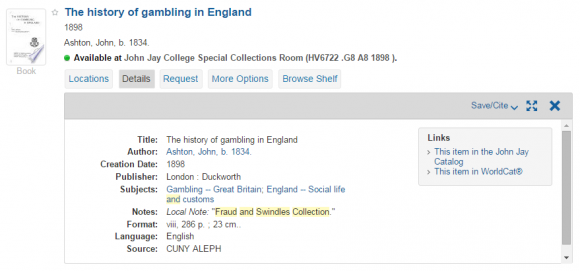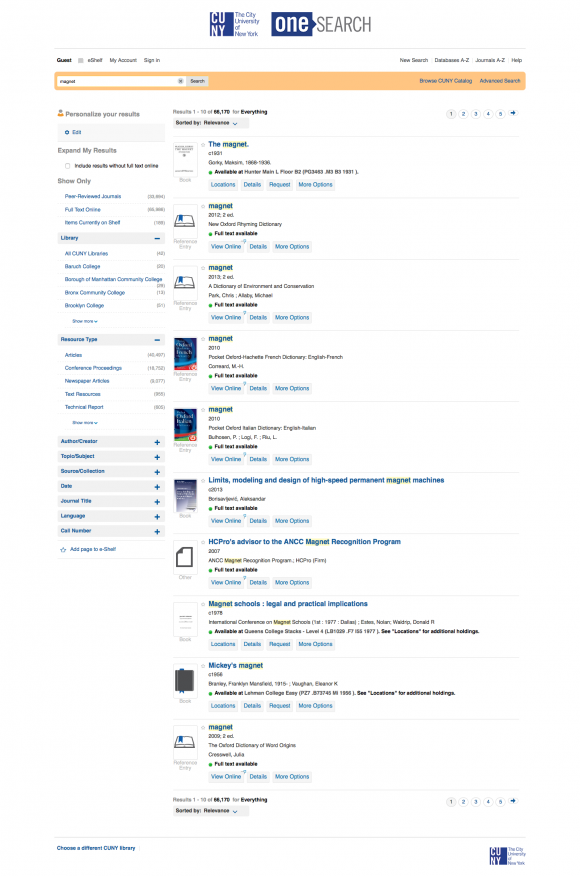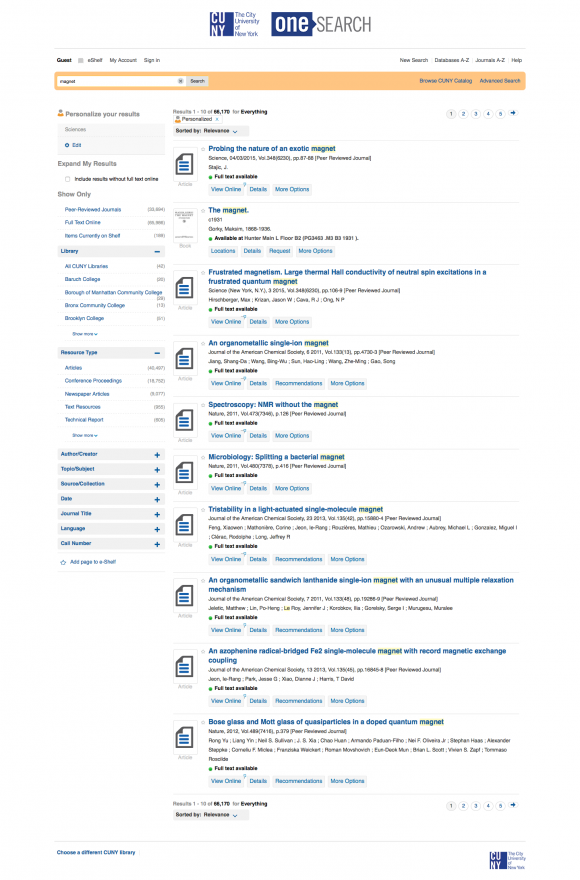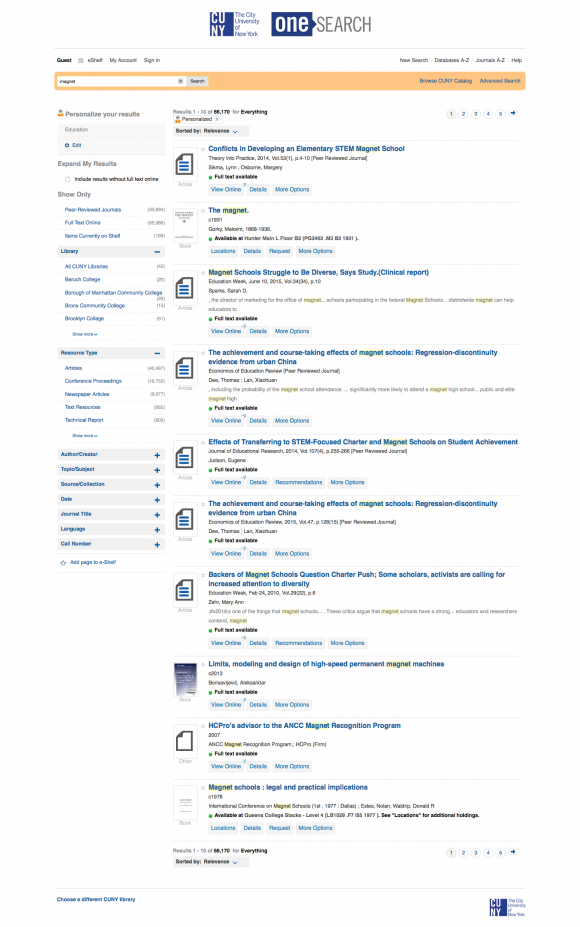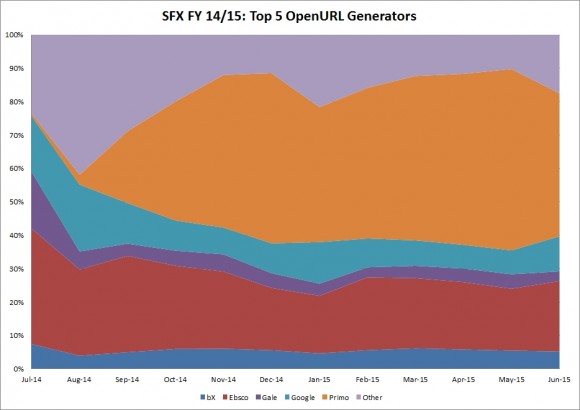Home » OneSearch (Page 5)
Category Archives: OneSearch
New ways to search OneSearch
Over the Labor Day weekend, the Office of Library Services added a handful of new fields to the search section of the PNX for records retrieved from the CUNY Catalog: MARC 5XX and MARC 250. (This was determined based on a survey OLS distributed to the Cataloging Committee and Public Services Committee in July 2015.) In layman’s terms? Your users will find more local results in their searches!
In technical terms, we’ve made the following MARC fields searchable in OneSearch:
- 250: Edition Statement
- 500: General Note
- 501: With Note
- 502: Dissertation Note
- 508: Creation/Production Credits Note
- 511: Participant or Performer Note
- 522: Geographic Coverage Note
- 546: Language Note
- 550: Issuing Body Note
- 585: Exhibition Note
- 586: Awards Note
- 590: Local Note
Users will now find videos when searching for an actor, specific editions of textbooks, items in a special collection, and more! To facilitate this, we’ve also included many more of these 5XX notes in the “Details” tab of each record with appropriate labels:
- 500 (no special label, other than general “Notes” field label)
- 501: With
- 502: Dissertation
- 504: Bibliography
- 506: Restrictions
- 507: Scale
- 508: Credits
- 511: Performers
- 515: Numbering
- 516: File Format
- 521: Intended Audience
- 522: Geographic Coverage
- 525: Supplements
- 530: Other Formats
- 533: Reproduction
- 534: Original Version
- 536: Funding Source
- 538: System Requirements
- 540: Use Restrictions
- 545: History Notes
- 546: Language
- 547: Former Title
- 550: Issuing Body
- 555: Finding Aids
- 580: Related Works
- 581: Publications About This Work
- 585: Exhibitions
- 586: Awards
- 590: Local Note
In the following example, you can see one of the results for the query “Fraud and Swindles Collection” in the John Jay instance of OneSearch:
Note that the “Local Note” field is not only searchable (as it came up for our exact phrase search) but is also displayed. In this way, users will know that they can search for other records in a similar way.
We hope these enrichments to the display and searchability of CUNY Catalog records in OneSearch will greatly improve the experiences of your students, staff, and faculty! Please let us know if you have any questions or concerns.
Personalize your OneSearch results!
As of mid-August, OneSearch users have the ability to personalize their results right from within the search screen. (Previously, this was only possible from within “My Account” in the user’s personal settings.) What does this mean? Basically, users can provide context for their queries.
The ambiguous search term “magnet,” for example, provides over 66,000 results:
Without any personalization, OneSearch doesn’t know which results are more relevant so it floats reference entries to the top of the result list. However, with some context, OneSearch is able to recalculate relevancy and re-position the results so the more relevant results appear on the first page of results.
For example, that same search for “magnet” within the context of the “Sciences” floats certain results to the top:
Within the context of “Education,” though, other results for “magnet” (previously buried within the thousands of other results) appear at the top:
In addition to choosing a discipline for personalization, there is also an option to float newer results to the top for cases where that makes sense:
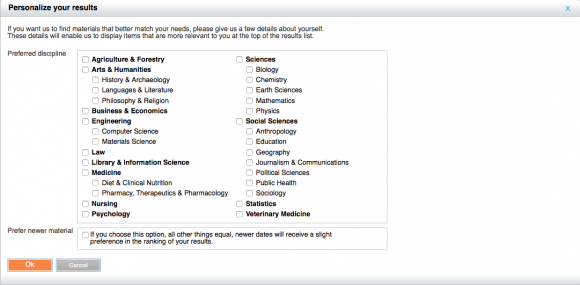
The results themselves never change, assuming the query remains the same. Personalizing results, instead, changes the relevancy of the returned results. This applies, therefore, only to results that are sorted by relevancy—which is the default sort order in OneSearch.
Another nice bonus of this updated OneSearch feature is that it clearly states, at the top of a user’s results, that the records the user is seeing are personalized. If the user wants to change the context or remove the personalization, it can easily be done from the results page:

We hope this helps your users find more relevant results in OneSearch!
Primo: Palgrave Connect
The CUNY-wide licensed ebook titles of the Palgrave Connect collection are now active in SFX and can be discovered in Primo.
In SFX, 6,491 portfolios are active for all of CUNY in the PALGRAVE_CONNECT_EBOOKS_COMPLETE target.
Impact of Primo on SFX
A few weeks ago, we (OLS staff) discussed ways in which the impact of Primo on other systems and environments could be illustrated.
A good place to start with is SFX, since it’s so heavily involved in creating fulltext links in Primo. So one way to measure Primo’s impact on SFX is to count the number of OpenURLs generated by Primo (either through “View Online”, or through the menu under “Other Options”) and compare them to other providers/generators of OpenURLs.
In FY 14/15, the top 5 providers were Primo, bX, Ebsco, Google, and Gale (For the remaining providers, the numbers drop significantly). Here’s a table with the number of OpenURLs generated each month by each provider:
bX Ebsco Gale Google Primo Other July-14 3052 14185 6990 6847 308 9672 August-14 1147 7512 1571 5821 859 12186 September-14 4477 25903 3289 10940 19302 25912 October-14 10651 44538 8009 16150 63698 35567 November-14 12934 49530 11050 17189 97932 25718 December-14 9506 31664 7530 15206 86557 19483 January-15 2583 9595 2030 6925 22495 12034 February-15 6194 24143 3317 9526 49877 17518 March-15 12127 41397 7257 15032 96998 24205 April-15 11756 40696 8220 14330 103400 23534 May-15 10033 33960 7951 13107 99598 18721 June-15 3494 14075 1955 7026 28637 11702 TOTAL OpenURLs: 1538333
I thought the best way to show the behavior over time is to use an area chart, because it shows how values (# of requests) change over time for different categories (OpenURL “generators”):
Since it’s implementation at the end of August 2014, Primo has quickly taken over a large share of the OpenURLs resolved by SFX, at a small expense to the other providers, but not by much. It actually looks as if the percentage of requests for the other main providers has remained relatively stable
The same chart in absolute numbers looks like this:
So it looks as if Primo has taken over a large share of the OpenURL requests, but not so much by taking them “away” from other providers but by simply increasing the number of OpenURLs.
The total number of SFX requests for FY13/14 was about 1.1 million (1,107,169). In the past FY, this increased by almost 40% to 1.5 million (1,538,333). And of these, 670K (669661) came from Primo.
Observations:
- In FY 14/15, Primo was responsible for over 40% of OpenURL requests, i.e. SFX menus
- It reached this number very quickly, within about 2 months of going live
- It simply increased the number of requests, and did not diminish the contribution of other vendors
- Given the impact on SFX, the impact on e-resource usage (search sessions, etc.) should be significant as well
